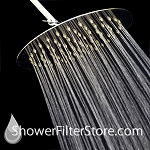Drinking Water Filters
Different Types of Drinking Water Filters
Drinking Water Filters filtration systems are designed to filter your water before you drink it. But what exactly is in water purifiers and what exactly do they do? Below, you will find some different kinds of drinking water purifier technologies and explanations as to how they purify your water. This article will go into more depth on how the purifiers work to purify the water that comes out of your tap.

Let's get started! Some of the common drinking water filters you may have heard of before are the Brita pitchers or the PUR water system. Both of these systems use a type of filtration technology called reverse osmosis. The idea behind reverse osmosis is to get rid of all solutes in the water that you drink. So essentially, it works by pushing water through a membrane, forcing everything in the water to be pushed to one side of the membrane. What happens is that the water you drink turns from a salty, cloudy brownish color to clear and shiny.
However, the reverse osmosis system is only one kind of drinking water filters. There are many different types. How do they all work and why are they different? Below, you will learn about some of the different types. This article will also touch on some methods you can use to test for safe drinking water filters. One type of drinking water filters that many people are familiar with is the inline filter.
An inline filter is a simple design that fits right onto your faucet, providing easy filtering options. They are generally made up of a porous media and either carbon or ceramic disc. The most common problem that can occur with an inline filter is that it can leave chemicals and debris in your drinking water. For this reason, you should always check with any company you are buying from that their product line includes a carbon block option. Countertop distillers are another popular type of drinking water filters.
These types use a closed looping mechanism to remove chlorine and heavy metals, along with the sediment and odor of organic compounds. The most common problems with countertop distillers are that they can remove too much trace minerals, leaving the consumer with a flavor that is less than desirable. However, since they use a smaller sized media than a typical carbon block filter, they do not have the same amount of particulates removed. As a result, they can still leave some trace mineral traces behind. The third option available for drinking water filters is the dual filtration system.
The first step is to make use of a carbon block filtration system with ion exchange and sub-micron filtration. This allows you to remove the major contaminants mentioned above as well as heavy metals like lead and aluminum. Unfortunately, these types of filters cannot get rid of the remaining bacteria in the water, which makes them ineffective in the long run. The last option available for filters is the ultraviolet light to kill filtration system. Ultraviolet light kills most bacteria in the water, but it also decimates a range of other microorganisms including those that cause deadly illnesses like cholera and typhoid.
These UV filters work by using an activated carbon base coupled with ultraviolet light, which will cause the bacteria to disintegrate and then pass right through the filter. There are a number of other processes that can be used in filters.
For example, there are carbon absorption filters that use a gel that is poured into the water, followed by the carbon filters. Or, carbon absorption and ion exchange filters will both use activated carbon to absorb contaminants and emit the purified water back into the household. Activated carbon and sub-micron filtration systems are the most commonly used, although they tend to be more costly. Regardless of what kind of filtration system you choose, remember to keep your drinking water clean and pure.
